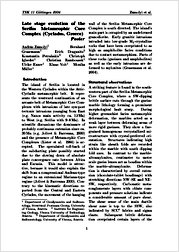Late stage evolution of the Serifos Metamorphic Core Complex (Cyclades, Greece)
Zámolyi, András
Grasemann, Bernhard
Draganits, Erich
Petrakakis, Konstantin
Iglseder, Christoph
Rambousek, Christian
Exner, Ulrike
Voit, Klaus
Müller, Monika
Universitätsverlag Göttingen
Sammelband- / Konferenzbeitrag
Verlagsversion
Deutsch
Zámolyi, András; Grasemann, Bernhard; Draganits, Erich; Petrakakis, Konstantin; Iglseder, Christoph; Rambousek, Christian; Exner, Ulrike; Voit, Klaus; Müller, Monika, 2006: Late stage evolution of the Serifos Metamorphic Core Complex (Cyclades, Greece). In: Philipp, S.; Leiss, B; Vollbrecht, A.; Tanner, D.; Gudmundsson, A. (eds.): 11. Symposium "Tektonik, Struktur- und Kristallingeologie"; 2006, Univ.-Verl. Göttingen, p. 248 - 249., , DOI: 10.23689/fidgeo-1835.
 |
Dokument öffnen: |
The island of Serifos is located in
the Western Cyclades within the Attic-
Cycladic metamorphic belt. It represents
the westward continuation of an
arcuate belt of Metamorphic Core Complexes
with intrusions of late syn-post
tectonic intrusions younging from East
(e.g. Naxos main activity ca. 12Ma)
to West (e.g. Serifos with 9–8Ma). In
scientific discussions the dominance of
probably continuous extension since ca.
30Ma (e.g. Jolivet & Faccenna, 2000)
and the presence of Metamorphic Core
Complexes (Lister et al. 1984) is accepted.
The speculated roll-back of
the subducting plate possibly started
due to the slowing down of absolute
plate convergence rate between Africa
and Eurasia. This model is attractive,
because it would also explain the
shift from a compressional Andean-type
regime to an extensional Mariana-type
regime (Jolivet & Faccenna 2000). Contrary
to the kinematic directions reported
from the Central and Eastern
Cyclades, the movement of the hanging wall of the Serifos Metamorphic Core
Complex is south directed. The island’s
main part is occupied by an undeformed
granodiorite. Early granitic intrusions
intruded into low-grade M2-crystalline
rocks that have been overprinted to as
high as amphibolite facies conditions
due to contact metamorphism. Parts of
these rocks (gneisses and amphibolites)
as well as the early intrusions are deformed
to mylonites (Grasemann et al.
2004).

